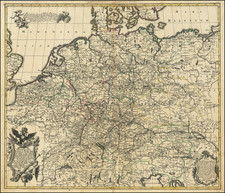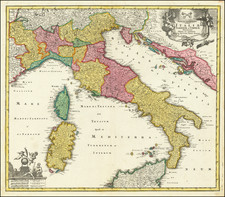This detailed map illustrates the regions significantly impacted by the War of Austrian Succession (1740-1748). The map prominently features the extensive course of the Danube River, Hungary, and neighboring kingdoms, extending to parts of Greece, the Morea Peninsula, and the islands of the Archipelago.
The map includes a striking allegorical cartouche. At the top, an angelic figure blowing a trumpet signifies the announcement or proclamation of the map's content. This figure embodies the spirit of victory and heralds the importance of the territories depicted. Adjacent to the angel, a warrior figure in classical armor, wielding a sword and a shield, represents martial strength and the conflict inherent to the War of Austrian Succession. Below the angel and the warrior, a large bird, likely an eagle, is engaged in a battle with a serpent. The eagle, often symbolizing power, authority, and imperial might is depicted overcoming the serpent, which traditionally represents treachery or adversarial forces. This imagery highlights the triumph of imperial forces over their enemies during the war. On either side of the cartouche, two subjugated combatants are shown.
The War of Austrian Succession, a major European conflict, was ignited by the death of Emperor Charles VI and the ensuing struggle over the succession rights of his daughter, Maria Theresa. The war involved several European powers, including Prussia, France, and Britain, each seeking to alter the balance of power through military and political maneuvering. The regions depicted on this map were central to many military campaigns and battles due to their strategic importance and geographical position.
Hungary, a key focus of the map, was a vital Habsburg territory, and its plains and fortresses became crucial battlegrounds. The conflict saw the Habsburg Monarchy defending its territories against various adversaries, notably the Prussian and Bavarian forces. The depiction of the Danube River underscores its role as a significant route for troop movements and supply lines, crucial for both offensive and defensive operations during the war.
The inclusion of Greece, the Morea Peninsula, and the Archipelagic islands highlights the broader geopolitical implications of the war. Although these regions were not the central theaters of the conflict, they were involved in the larger strategic considerations of the warring states, particularly in terms of naval power and control of sea routes. The Mediterranean and Aegean seas were vital for maritime engagements and the transport of troops and resources, influencing the course of the war.
Matthäus Seutter (1678-1757) was a prominent German mapmaker in the mid-eighteenth century. Initially apprenticed to a brewer, he trained as an engraver under Johann Baptist Homann in Nuremburg before setting up shop in his native Augsburg. In 1727 he was granted the title Imperial Geographer. His most famous work is Atlas Novus Sive Tabulae Geographicae, published in two volumes ca. 1730, although the majority of his maps are based on earlier work by other cartographers like the Homanns, Delisles, and de Fer.
Alternative spellings: Matthias Seutter, Mathaus Seutter, Matthaeus Seutter, Mattheus Seutter










![(Manuscript Map of Budapest) Bude attacque par les ducs de Lorraine... [Buda Attacked by the Dukes of Lorraine]](https://storage.googleapis.com/raremaps/img/small/95273.jpg)

![[ Romania / Bucharest ] Das Fursthum Walachey](https://storage.googleapis.com/raremaps/img/small/102819.jpg)

